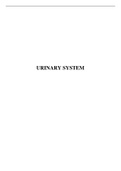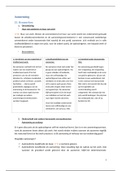URINARY SYSTEM
,Lesson 1 – Overview of Urinary System
Total Body Water
Body weight = solids + water
Solids (40% for males, 50% for females)
Water (60% for males, 50% for females)
This difference due to sex reflects the proportionality of larger mass of adipose tissues in females and larger
mass of muscle tissues in males.
Solids → proteins, lipids, carbohydrates, minerals
The water component (TBW) can be divided into the total body fluid: extracellular fluid (1/3) + intracellular
fluid (2/3)
TBW = ECF (1/3) + ISF (2/3)
Extracellular Intracellular
Plasma – fluid in circulation (20%) Fluid found within in the cells
Interstitial fluid -fluid between cells (80%)
Main fluid input is from food and water from the gastrointestinal tract = 2500 ml water required per day
Water moves passively through fluid compartments in response to osmotic gradient
Main fluid output occurs from kidney, lungs, GIT, skin = 2500 ml of water is lost everyday
If fluid becomes excess and accumulates in the interstitial fluid forming a clog. The body then helps drain the
excess fluid through the lymphatic system from the interstitial fluid to the venous circulation.
Electrolytes
Main electrolytes in the plasma are sodium, potassium, calcium, chloride and then a small amt of proteins
The concentration of these electrolytes are relatively the same in both the plasma and the interstitial fluid,
except for proteins, which are found in the plasma and intracellular fluid only, not the interstitial fluid. These
electrolytes can passively move between the plasma membrane and interstitial fluid through a semipermeable
membrane but require protein channels to assist movement from interstitial fluid to intracellular fluid.
Extracellular fluid Intracellular fluid
Chloride – main anion Potassium – main cation
Sodium – main cation Phosphorus – main anion
Albumin is the main protein found in plasma which helps maintain osmotic gradient by keeping water in blood
vessels.
Bicarbonate ions are important in acid base balance
,Function of the Excretory system:
- To maintain homeostasis
- Controls volume of body fluids (water)
- Balances chemical composition of body fluids by balancing the solute concentration → dissolved
solute concentration as well as different ions, vitamins + minerals in the body
Questions to answer
a) Physiological fluid inside the lumen of blood vessels is part of the extracellular fluid compartment?
b) What is fluid inside of a cell called? Intracellular fluid
c) What is fluid that is present outside of a cell called? Extracellular fluid
d) What is the fluid in between cells called? Interstitial fluid
e) Which compartment contains majority of fluid by mass in the human body? Intracellular fluid
compartment
f) How do body fluid compartments differ with respect to their volumes and their ionic compositions?
- Volumes: ECF makes up 1/3 of the total body water (plasma = 20% + interstitial fluid = 80%) and ICF
makes up 2/3 of the total body water
- Electrolytes in solution: both plasm and interstitial fluid have similar concentrations of Na+ K+ Ca2+
Cl- due to passive transport through semipermeable membrane. Only plasma and ICF have proteins
such as albumin which helps to maintain osmotic gradient.
g) What are the driving forces responsible for movement of water across cell membranes and the capillary
wall?
Osmotic gradient + Osmolarity
h) What types of transport mechanisms allows for solute movement across the fluid compartments?
Passive transport: from plasma to ISF. Passive diffusion, no energy required through semipermeable
membrane.
Facilitated diffusion via protein channels allowing for movement of ions from ISF to ICF
Active transport
, Total Body Water (TBW) varies for various sexes and ages
Sexes:
TBW - 60% for males and 50% for females.
- Males have higher muscle mass whereas females have higher fat content.
Ages:
Infants:
75% of their total body weight is made up of water as they are still developing and have low body fat and low
bone mass.
Diarrhoea is dangerous for infants as it causes extreme water loss (dehydration) and hence in infants, extreme
body weight loss
Water content declines with old age
EQUATIONS
Body Weight x 0.60 = TBW
Use 60 – 40 – 20 rule to calculate TBW %
TBW = 0.60 x body weight
ICF = 2/3 x TBW OR ICF = 0.40 x body weight
ECF = 1/3 x TBW OR ECF = 0.20 x body weight
ISF = ECF x 0.80
Plasma = ECF x 0.20
Cells with intracellular fluids are bathed in the interstitial fluids, and then blood plasma and interstitial fluids
will experience an exchange of contents or solutes depending on the different processes taking place within
the body.
,Lesson 1 – Overview of Urinary System
Total Body Water
Body weight = solids + water
Solids (40% for males, 50% for females)
Water (60% for males, 50% for females)
This difference due to sex reflects the proportionality of larger mass of adipose tissues in females and larger
mass of muscle tissues in males.
Solids → proteins, lipids, carbohydrates, minerals
The water component (TBW) can be divided into the total body fluid: extracellular fluid (1/3) + intracellular
fluid (2/3)
TBW = ECF (1/3) + ISF (2/3)
Extracellular Intracellular
Plasma – fluid in circulation (20%) Fluid found within in the cells
Interstitial fluid -fluid between cells (80%)
Main fluid input is from food and water from the gastrointestinal tract = 2500 ml water required per day
Water moves passively through fluid compartments in response to osmotic gradient
Main fluid output occurs from kidney, lungs, GIT, skin = 2500 ml of water is lost everyday
If fluid becomes excess and accumulates in the interstitial fluid forming a clog. The body then helps drain the
excess fluid through the lymphatic system from the interstitial fluid to the venous circulation.
Electrolytes
Main electrolytes in the plasma are sodium, potassium, calcium, chloride and then a small amt of proteins
The concentration of these electrolytes are relatively the same in both the plasma and the interstitial fluid,
except for proteins, which are found in the plasma and intracellular fluid only, not the interstitial fluid. These
electrolytes can passively move between the plasma membrane and interstitial fluid through a semipermeable
membrane but require protein channels to assist movement from interstitial fluid to intracellular fluid.
Extracellular fluid Intracellular fluid
Chloride – main anion Potassium – main cation
Sodium – main cation Phosphorus – main anion
Albumin is the main protein found in plasma which helps maintain osmotic gradient by keeping water in blood
vessels.
Bicarbonate ions are important in acid base balance
,Function of the Excretory system:
- To maintain homeostasis
- Controls volume of body fluids (water)
- Balances chemical composition of body fluids by balancing the solute concentration → dissolved
solute concentration as well as different ions, vitamins + minerals in the body
Questions to answer
a) Physiological fluid inside the lumen of blood vessels is part of the extracellular fluid compartment?
b) What is fluid inside of a cell called? Intracellular fluid
c) What is fluid that is present outside of a cell called? Extracellular fluid
d) What is the fluid in between cells called? Interstitial fluid
e) Which compartment contains majority of fluid by mass in the human body? Intracellular fluid
compartment
f) How do body fluid compartments differ with respect to their volumes and their ionic compositions?
- Volumes: ECF makes up 1/3 of the total body water (plasma = 20% + interstitial fluid = 80%) and ICF
makes up 2/3 of the total body water
- Electrolytes in solution: both plasm and interstitial fluid have similar concentrations of Na+ K+ Ca2+
Cl- due to passive transport through semipermeable membrane. Only plasma and ICF have proteins
such as albumin which helps to maintain osmotic gradient.
g) What are the driving forces responsible for movement of water across cell membranes and the capillary
wall?
Osmotic gradient + Osmolarity
h) What types of transport mechanisms allows for solute movement across the fluid compartments?
Passive transport: from plasma to ISF. Passive diffusion, no energy required through semipermeable
membrane.
Facilitated diffusion via protein channels allowing for movement of ions from ISF to ICF
Active transport
, Total Body Water (TBW) varies for various sexes and ages
Sexes:
TBW - 60% for males and 50% for females.
- Males have higher muscle mass whereas females have higher fat content.
Ages:
Infants:
75% of their total body weight is made up of water as they are still developing and have low body fat and low
bone mass.
Diarrhoea is dangerous for infants as it causes extreme water loss (dehydration) and hence in infants, extreme
body weight loss
Water content declines with old age
EQUATIONS
Body Weight x 0.60 = TBW
Use 60 – 40 – 20 rule to calculate TBW %
TBW = 0.60 x body weight
ICF = 2/3 x TBW OR ICF = 0.40 x body weight
ECF = 1/3 x TBW OR ECF = 0.20 x body weight
ISF = ECF x 0.80
Plasma = ECF x 0.20
Cells with intracellular fluids are bathed in the interstitial fluids, and then blood plasma and interstitial fluids
will experience an exchange of contents or solutes depending on the different processes taking place within
the body.



